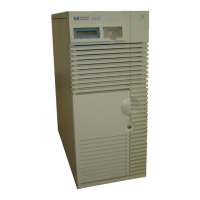Chapter 11 11-49
SCSI Peripherals and I/O Information
Forced Eject
There are some situations where the user's depression of the eject button may not cause a cartridge to
be ejected within an acceptable time. For instance, the media surface may be badly damaged and the
drive is having trouble recovering data. Or, the cartridge may be of poor quality and has jammed one
of its reels which prevents it turning. In these and many similar situations, the drive will usually
invoke a series of error recovery actions in an attempt to carry out the task it was given before the eject
button was pressed. As the normal eject request is queued by the drive until it has completed any
pending operations (i.e. flushing data from the buffer to tape, writing EOD, rewinding, etc.) some
users may become frustrated at the apparent lack of response to their depression of the eject button.
For this reason, the Forced Eject feature is provided. This allows the user to request the drive to
immediately eject the cartridge regardless of any operations outstanding or error recovery actions in
progress.
Triggering a Forced Eject
The first eject button press with a tape present in the drive will always trigger a normal eject. After this
first press, the following actions by the user will trigger a forced eject:
• Two more momentary presses within 5 minutes of the first press, or
• Three momentary presses in any subsequent 5 minute period, or
• One long press where the button is held down for at least 5 seconds.
Note also that, for the purposes of triggering a forced eject, a SCSI unload command may be taken
to be functionally equivalent to pressing the eject button for the first time. When the drive is
self-configuring after a power cycle or a SCSI hard reset, the eject button is ignored for a period of
about five seconds. This happens because the drive is running kernel diagnostics and the main
firmware has not yet started to run. During this time eject button presses will not register and will
not contribute towards the forced eject trigger criteria.
Forced Eject Action
Once a forced eject has been triggered, the drive will wait for a period of approximately 35 seconds
from the time of the first press (the one that attempted to start the normal eject). Once this time-out, or
period of grace, has passed the drive will carry out a forced eject. This will cause the tape to be
immediately unthreaded and ejected regardless of any operation that the drive may be carrying out.
Once the tape has been ejected a firmware reset will be carried out as if the drive had been power
cycled.
Consequences of a Forced Eject
The drive can be performing any action at the time a forced eject is executed. There is a possibility
that during a write, data may be lost and an invalid format tape could be created (as EOD may not be
written correctly). It is for this reason that the drive allows itself the 35 second grace period in which
to attempt a normal eject. If the normal eject succeeds within the 35 second period, then any pending
forced eject will be cancelled.

